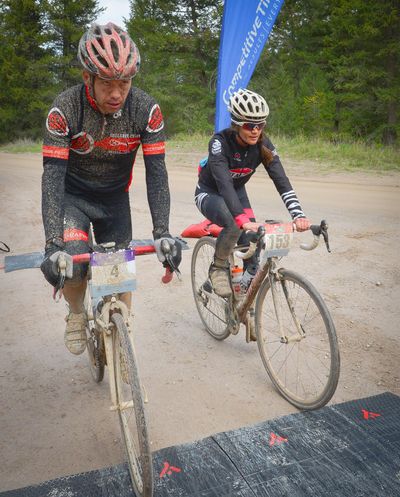It’s called the Montana Hell Ride for a reason

MISSOULA, Mont. – The race is hard enough as it is. It’s called the Montana Hell Ride for a reason.
But this year’s race in the hills outside Missoula recently was even more hellish than usual. It was raining at the start of the race and had been raining for two days.
Normally, a little rain during a bicycle race is just a bother. But the Hell Ride is a gravel race, with most of it on dirt roads and rutted forest roads, and just enough pavement that you can catch your breath, if you hurry.
A few riders didn’t even start the race. Warming up before the start, I watched two guys load their bikes back on their car and zip away.
That’s the thing about gravel racing, even in the best conditions it’s hard as hell.
It’s also a blast, and gravel races are catching on all over the country. It’s like road racing, only bumpier and it’s harder to ride in a pack. And it’s like mountain bike racing, only much faster and the races are longer. It’s not unusual to be in the saddle four or five hours, or longer.
Bike manufacturers are noticing and have started designing bikes specifically for gravel roads. Kona has the “Rove,” with longer chain stays for stability. Salsa has the “Warbird,” with a “smash-proof” titanium frame and “chatter-defeating” carbon disc forks. Raleigh’s “Tamland” has a lower bottom bracket, which adds to stability.
For now, most riders are modifying the bikes they have. I rode a 10-year-old cyclocross bike, the same bike I commute to work on, only with wider, heavy-duty treaded tires that I mounted specifically for the race. The trick on gravel roads is to avoid flats, either from punctures or “snake bites,” when hitting a sharp bump causes the tube to pinch against the rim. Entire websites are devoted to arguing over the proper tires and air pressure for gravel races.
The organizers of the Hell Ride “strongly suggest” racers carry at least two spare tubes, and 15 miles into the race I was at the roadside kneeling over my bike in the wet grass fixing a flat. About 200 yards up the road, I could see another racer fixing a flat.
The flat tire was actually a relief. I had been traveling in the main group, blazing along at more than 25 mph. Gritty mud spraying from the wheels in front of me was blinding. And while things slowed down in the mountains, sections of the forest road were rutted and slippery, with every low spot a puddle.
But it did stop raining.
The Hell Ride offers two routes, one 52 miles, the other route – weirdly more popular – is 83 miles. The strongest riders in that longer race were finishing in just over four hours, and there were plenty of racers wobbling in at over five and six hours.
Shaun Radley, with the Cycling House in Missoula, organizes the race. He believes cyclists, like runners, may get bored with the same old races. Runners now have races in the mud bogs, races where you get doused with brightly colored powder, rock-n-roll runs and other gimmicks.
“Gravel racing is something different,” Radley said. “It’s adventurous and a new type of challenge for a lot of people.”
To pull off the Missoula race, organizers got a permit from the Forest Service, which in the future has the potential to open up many new and scenic routes for cycling events. Some gravel races are organized to appeal to cyclists who want to race, while others treat it like a tour with friends.
“Half the field in that race had probably never raced before,” Radley said. “So for some it’s just ‘me against the clock,’ or ‘me on a group ride with friends,’ and some it’s a race against the whole pack.”
In Red Lodge, small business owner and racer Paul Otsu leads several group rides a year on gravel roads, some of them around 80 miles, and he organizes a few races. Last year he competed in the Mother Lode gravel race, 210 miles through the South Dakota Black Hills. He finished well, in 14 hours.
Cyclists have always ridden on dirt roads. In Europe even the biggest professional stage races like the Tour de France and the Giro d’Italia occasionally have stretches of dirt or cobbles.
But bikes have been designed to be more comfortable recently, Otsu said, making it possible to enjoy long, fast rides on dirt roads. The bonus, he said, is that with few cars on the road the rides are safer and can ride in a group.
“For cyclists, I think gravel riding is a mix of what everyone loves about each type of cycling,” Otsu said. “You have the distance and speed of road biking and the adventure of mountain biking.”
Plus, he said, you don’t have to speed through it if you don’t want to.
“You can go slow, enjoy the view and the company, bring a sandwich, have a good time,” he said.